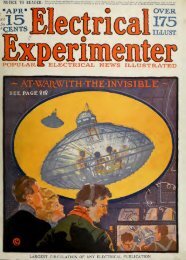The Electrical experimenter
The Electrical experimenter
The Electrical experimenter
Create successful ePaper yourself
Turn your PDF publications into a flip-book with our unique Google optimized e-Paper software.
May, 1917 THE ELECTRICAL EXPERIMENTER 25<br />
Simple Apparatus Comprising Box, Candle<br />
and Two Lamp Chimneys for Demonstrating<br />
the Principle of Ventilation.<br />
and become liglitcr and the heavier air at<br />
the top of the room will fall, forcing the<br />
lighter air upward. Thus it is that the air<br />
near the ceiling is always warmer than<br />
that near the floor. This shows the necessity<br />
of opening a window at both the<br />
top and the bottom for best ventilation.<br />
EXPERI.MFXT 19—<br />
Fig. 15 .shows very simple apparatus<br />
which can he made with practically any<br />
material available, for demonstrating the<br />
behavior of air near a source of heat.<br />
C, is a box thru which holes have been<br />
cut to admit tul)es (or glass lamp chimneys)<br />
B. 'A is a lighted candle. <strong>The</strong><br />
arrows show the direction of the current<br />
of air.<br />
EXPERIMEXT ^0—<br />
An interesting experiment giving surprising<br />
results and having a simple explanation<br />
can be performed by the use of<br />
a spool and a visiting card. (If no visiting<br />
card is available, the ace from a poker<br />
deck whicli you may have "up your sleeve,"<br />
will do very well.) Place the card up<br />
against the bottom of the spool as in Fig.<br />
16-A and the mouth against t e top of the<br />
spool. Blow vigorously and then let go<br />
of the card. One would naturally expect<br />
that blowing against the card would blow<br />
Experimental Physics<br />
By JOHN J. FURIA, A. B., M. A.<br />
Inatruc tor in Physics and Science Master, Riverdale Country School<br />
LESSON FOUR<br />
and was sucked out; i.e., there is no air<br />
GASES ANU THE ATMOSPHERE<br />
pressure in the tube and the air pressure<br />
(Concluded)<br />
outside can hold up the mercury to a level<br />
rxpands when heated and bc-<br />
of about thirty inches. If now the seal<br />
AIRtnmcs lighter in weight. If we<br />
is broken the air rushes in and the mer-<br />
liave a confined bodv of air such<br />
cury in the tube falls into the cup. (See<br />
as in a room, for example, and<br />
Fig. 18-.\.) <strong>The</strong> pressure of tlie atmos-<br />
there is a source of heat in the<br />
phere changes from place to place and<br />
room, the air near the source will expand<br />
from time to time. It is, therefore, im-<br />
C/osed/<br />
enc/<br />
Fig- '6<br />
Closed/<br />
end<br />
A Glass Tube, Sealed at One End and Filled<br />
with IVIerctiry, Will Support a 30-inch Column<br />
of Mercury. Owing to Atmospheric Pressure<br />
Acting Against a Vacuum. <strong>The</strong> Principle<br />
of the Barometer.<br />
it away whereas actually the card stays<br />
fast, close to the, bottom of the spool.<br />
Sometimes, when the conditions are not<br />
just right, the card slides off perpendicular<br />
to the direction in which one blows, but<br />
to avoid this a pin should be stuck thru<br />
the card's center and tlien into the hole in<br />
the spool (care being taken not to stick<br />
it into the wood of the spool). Fig. 16-B<br />
shows diagrammatically what happens. <strong>The</strong><br />
air from the moutli passes down the hole<br />
in the spool and out along the upper surface<br />
of the card. It is a well-known fact<br />
that the pressure is greatest where the<br />
speed is least and vice versa. <strong>The</strong> air<br />
underneath the card is practically still,<br />
while that just alK>ve the card is in rapid<br />
motion, and hence the pressure against the<br />
card from beneath is greater than that<br />
from above. Hence the card tends to get<br />
as close to the spool as possible and does<br />
not fall.<br />
EXPERIMENT 21—<br />
In the First Lesson we learned that at<br />
any depth in a liquid there is a pressure<br />
due to the weight of the liquid above that<br />
depth. We also learned that air has<br />
weight and consequently we conclude that<br />
the air (at the surface of the earth) has<br />
pressure due to the weight of the air above<br />
it. <strong>The</strong> higher up we go, the less air<br />
there is above us and hence the pressure<br />
is less. If one sucks in at the stem of a<br />
pipe (see Fig. 17) at the bowl of which<br />
is stretched a piece of sheet elastic, the<br />
pressure of the air above it pushes the<br />
elastic down. Suction is not a mysterious<br />
force: it is simply a removal of the air<br />
from one side so that the pressure from<br />
Removing the Air V^ithin a Pipe Bowl by<br />
Sucl




